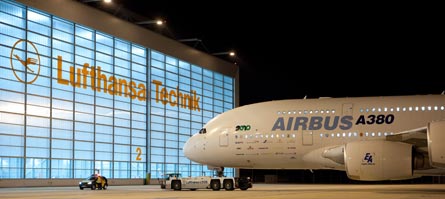Lufthansa's first Airbus A380 will be among the main attractions of ILA's flying display - and its presence at the air show will be partly thanks to the airline's maintenance organisation Lufthansa Technik.
Delivery of the German carrier's first superjumbo - originally scheduled for 2007 - took place on 19 May, but only after Airbus had asked Lufthansa Technik for help with the aircraft's cabin furnishings. The German company responded by assigning a team of more than 30 employees to the project.
Lufthansa Technik's involvement with the A380 stretches back to the days when the programme was known as the A3XX. From 2001, Lufthansa Technik engineers were enlisted in customer focus groups as Airbus sought to ensure that the aircraft's design optimised maintainability. When the manufacturer teamed with operators and civil aviation authorities to form the industrial steering committee that would draw up the A380's first maintenance schedule, Lufthansa Technik was appointed to chair the new body.
In another A380-related collaboration, Lufthansa and Air France established the Spairliners joint venture tasked with providing component support not just for the 27 A380s the two airlines had on order, but for those of any superjumbo operator seeking to reduce investment in initial provisioning via a pooling arrangement.
|
|---|
Qantas took the opportunity, awarding Spairliners a 10-year technical service contract covering 20 A380s. The Australian airline was in Spairliners' launch, receiving its first A380 a full year before Air France did.
Collaboration was also pursued to prepare for maintaining the engines powering A380s, as Lufthansa Technik teamed with manufacturer Rolls-Royce to open N3 Engine Overhaul Services in April 2007. Located in Arnstadt in Germany, N3 has capability on all of Rolls-Royce's large three-shaft turbofans, including the Trent 500 and 700 as well as the 900.
At its own facility in Frankfurt - the hub of its line maintenance activities - Lufthansa Technik completed the first phase of a two-phase greenfield project when, in January 2008, it opened a 25,000m2 (270,000ft2) A380 maintenance hangar with room for two superjumbos (or three Boeing 747s).
On completion of the second phase of the €150 million ($185 million) project - originally scheduled for 2015, but delayed by the recession - the hangar will have capacity for four A380s. In February 2008, a hangar of similar capacity was opened by Ameco Beijing, a Lufthansa-Air China joint venture.
The Frankfurt hangar has overhead clearance of 27.5m (90ft) and has room for the A380's tailfin, which reaches a height of 24m. The A380's dimensions similarly necessitated acquisition of new maintenance tools, including tripod jacks to lift the aircraft for landing gear maintenance and special torque wrenches to remove and install engine mounts.
Special ground support equipment was also required. A tail dock scalable to the A380 - but also capable of handling other widebody types - was manufactured for Lufthansa Technik by Dutch company NIJL Aircraft Docking. A new nose dock was also acquired, along with mobile platforms for wing docking.
Lufthansa Engineering and Operational Services was meanwhile engaged to develop a tow tractor able to pull an aircraft with a maximum take-off weight of 560t. Lufthansa Technik Logistik opened a neighbouring facility housing 70.000 different parts, furthering the A380 hangar's preparedness.
TRAINING PROGRAMME
To ensure that Lufthansa Technik employees were equally ready to take on the superjumbo, Lufthansa Technical Training worked with Airbus to produce an A380 maintenance training programme. So far, 80 Lufthansa Technik employees have been licensed to work on the type.
Delivery delays at least meant that Lufthansa Technik could learn from the experiences of other operators, such as the type's launch customer Singapore Airlines, which received its first superjumbo in October 2007, and Emirates Airline, which put the A380 into service in August 2008. Some information was communicated to Lufthansa Technik by Airbus, and some by other airlines, via bilateral arrangements.
"I think our guys are prepared well enough to have a very reliable operation for Lufthansa as soon as we have our first aircraft into service," says Lufthansa Technik's director for new aircraft readiness Dean Raineri.
The big day arrives on 11 June, when Lufthansa launch A380 service on the Frankfurt-Tokyo route. By autumn, four A380s will be in the Lufthansa fleet, operating to Beijing and Johannesburg.
Meanwhile, Lufthansa Bombardier Aviation Services (LBAS) continues to expand its capabilities. The Berlin Schönefeld-based joint venture - formed by Lufthansa Technik (51%), Bombardier (29%) and ExecuJet (20%) - has gained continued airworthiness management organisation (CAMO) approval from the European Aviation Safety Agency and the civil aviation authorities of Bermuda and the Cayman Islands, these being the three regulators requiring CAMO compliance by aircraft operators. Supplementing Bombardier's factory-owned service centre network for business jets outside North America, LBAS serves a customer base operating 750-plus aircraft.
Additional reporting by David Kaminski-Morrow
Source: Flight International
























